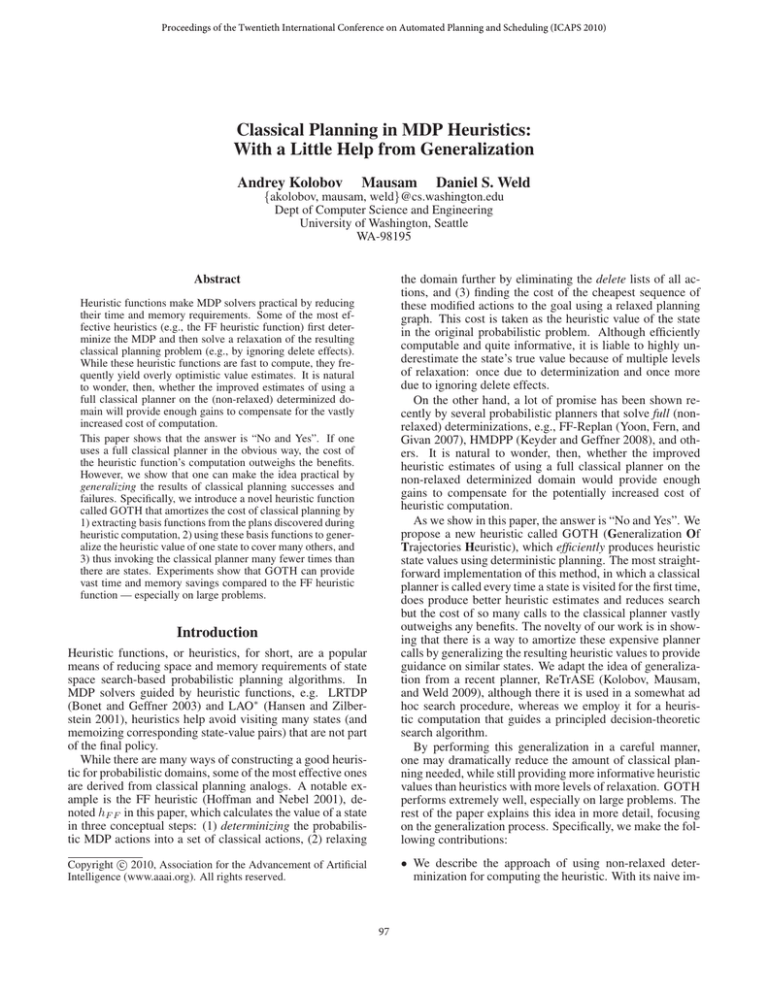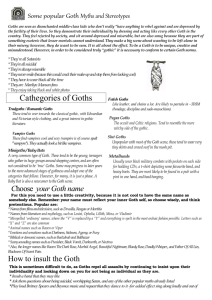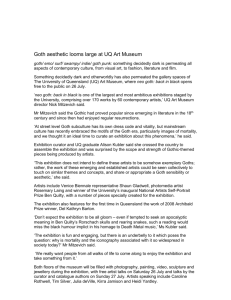
Proceedings of the Twentieth International Conference on Automated Planning and Scheduling (ICAPS 2010)
Classical Planning in MDP Heuristics:
With a Little Help from Generalization
Andrey Kolobov
Mausam
Daniel S. Weld
{akolobov, mausam, weld}@cs.washington.edu
Dept of Computer Science and Engineering
University of Washington, Seattle
WA-98195
Heuristic functions, or heuristics, for short, are a popular
means of reducing space and memory requirements of state
space search-based probabilistic planning algorithms. In
MDP solvers guided by heuristic functions, e.g. LRTDP
(Bonet and Geffner 2003) and LAO∗ (Hansen and Zilberstein 2001), heuristics help avoid visiting many states (and
memoizing corresponding state-value pairs) that are not part
of the final policy.
While there are many ways of constructing a good heuristic for probabilistic domains, some of the most effective ones
are derived from classical planning analogs. A notable example is the FF heuristic (Hoffman and Nebel 2001), denoted hF F in this paper, which calculates the value of a state
in three conceptual steps: (1) determinizing the probabilistic MDP actions into a set of classical actions, (2) relaxing
the domain further by eliminating the delete lists of all actions, and (3) finding the cost of the cheapest sequence of
these modified actions to the goal using a relaxed planning
graph. This cost is taken as the heuristic value of the state
in the original probabilistic problem. Although efficiently
computable and quite informative, it is liable to highly underestimate the state’s true value because of multiple levels
of relaxation: once due to determinization and once more
due to ignoring delete effects.
On the other hand, a lot of promise has been shown recently by several probabilistic planners that solve full (nonrelaxed) determinizations, e.g., FF-Replan (Yoon, Fern, and
Givan 2007), HMDPP (Keyder and Geffner 2008), and others. It is natural to wonder, then, whether the improved
heuristic estimates of using a full classical planner on the
non-relaxed determinized domain would provide enough
gains to compensate for the potentially increased cost of
heuristic computation.
As we show in this paper, the answer is “No and Yes”. We
propose a new heuristic called GOTH (Generalization Of
Trajectories Heuristic), which efficiently produces heuristic
state values using deterministic planning. The most straightforward implementation of this method, in which a classical
planner is called every time a state is visited for the first time,
does produce better heuristic estimates and reduces search
but the cost of so many calls to the classical planner vastly
outweighs any benefits. The novelty of our work is in showing that there is a way to amortize these expensive planner
calls by generalizing the resulting heuristic values to provide
guidance on similar states. We adapt the idea of generalization from a recent planner, ReTrASE (Kolobov, Mausam,
and Weld 2009), although there it is used in a somewhat ad
hoc search procedure, whereas we employ it for a heuristic computation that guides a principled decision-theoretic
search algorithm.
By performing this generalization in a careful manner,
one may dramatically reduce the amount of classical planning needed, while still providing more informative heuristic
values than heuristics with more levels of relaxation. GOTH
performs extremely well, especially on large problems. The
rest of the paper explains this idea in more detail, focusing
on the generalization process. Specifically, we make the following contributions:
c 2010, Association for the Advancement of Artificial
Copyright Intelligence (www.aaai.org). All rights reserved.
• We describe the approach of using non-relaxed determinization for computing the heuristic. With its naive im-
Abstract
Heuristic functions make MDP solvers practical by reducing
their time and memory requirements. Some of the most effective heuristics (e.g., the FF heuristic function) first determinize the MDP and then solve a relaxation of the resulting
classical planning problem (e.g., by ignoring delete effects).
While these heuristic functions are fast to compute, they frequently yield overly optimistic value estimates. It is natural
to wonder, then, whether the improved estimates of using a
full classical planner on the (non-relaxed) determinized domain will provide enough gains to compensate for the vastly
increased cost of computation.
This paper shows that the answer is “No and Yes”. If one
uses a full classical planner in the obvious way, the cost of
the heuristic function’s computation outweighs the benefits.
However, we show that one can make the idea practical by
generalizing the results of classical planning successes and
failures. Specifically, we introduce a novel heuristic function
called GOTH that amortizes the cost of classical planning by
1) extracting basis functions from the plans discovered during
heuristic computation, 2) using these basis functions to generalize the heuristic value of one state to cover many others, and
3) thus invoking the classical planner many fewer times than
there are states. Experiments show that GOTH can provide
vast time and memory savings compared to the FF heuristic
function — especially on large problems.
Introduction
97
in the trial path using Bellman backups. A popular variant,
LRTDP, adds a termination condition to RTDP by labeling
those states whose values have converged as ‘solved’ (Bonet
and Geffner 2003). Compared to VI, trial-based methods
save space by considering fewer irrelevant states. LRTDP
serves as the testbed in our experiments, but the approach
we present can be used by many other search-based MDP
solvers as well, e.g., LAO∗ .
Heuristic Functions. We define a heuristic function, hereafter termed simply as heuristic, as a value function used
to initialize the state values before the first time an algorithm updates these values. In heuristic-guided algorithms,
heuristics help avoid visiting irrelevant states. To guarantee convergence to an optimal policy, MDP solvers require
a heuristic to be admissible, i.e. to never overestimate the
optimal value of a state (importantly, admissibility is not a
requirement for convergence to a policy). However, inadmissible heuristics tend to be more informative in practice,
approximating V ∗ better on average. Informativeness often translates into a smaller number of explored states (and
the associated memory savings) with reasonable sacrifices
in optimality. In this paper, we strive to obtain an informative heuristic even at the cost of admissibility, and adopt the
number of states visited by a planner under the guidance of a
heuristic as the measure of that heuristic’s informativeness.
Determinization. Some of the most effective domainindependent heuristics known today are based on determinizing the probabilistic domain at hand. Determinizing domain D removes the uncertainty about D’s action
outcomes in a variety of ways. For example, the alloutcomes determinization, for each action a with precondition c and outcomes o1 , . . . , on with respective probabilities p1 , . . . , pn , produces a set of deterministic actions
a1 , . . . , an , each with precondition c and effect oi , yielding
a classical domain Dd . To obtain a value for state s in D,
determinization heuristics try to approximate the cost of a
plan from s to a goal in Dd (finding a plan itself is generally
NP-hard). For instance, hF F ignores the delete effects of all
actions in Dd and attempts to find the cost of the cheapest
solution to this new relaxed problem.
plementation we obtain much more informative heuristic
values but at a large performance loss.
• We apply a generalization procedure to amortize the classical planner invocations leading to a very efficient procedure for heuristic computation. We implement it over
miniGPT’s version of labeled RTDP (Bonet and Geffner
2005), and empirically demonstrate that this new approach can be hundreds of times faster than the naive
one with very little sacrifice in heuristic quality. Thus, we
show generalization to be key to GOTH’s time efficiency.
• We experimentally compare our GOTH implementation
against hF F , a state of the art heuristic for probabilistic planning. Our results show that for large problems
in five out of six benchmark domains we massively outperform hF F in terms of memory requirements, attesting to GOTH’s higher informativeness, as well as time
efficiency. We find that LRTDP+hF F exhausts memory
on several problems that LRTDP+GOTH is able to solve
easily. Additionally, our solution quality is never worse
and often better than LRTDP+hF F .
Background
Markov Decision Processes (MDPs). In this paper, we focus on probabilistic planning problems that are modeled by
factored indefinite-horizon MDPs. They are defined as tuples of the form S, A, T , C, G, s0 , where S is a finite set
of states, A is a finite set of actions, T is a transition function S × A × S → [0, 1] giving the probability of moving
from si to sj by executing a, C is a map S × A → R+
specifying action costs, s0 is the start state, and G is a set of
(absorbing) goal states. Indefinite horizon refers to the fact
that the total action cost is accumulated over a finite-length
action sequence whose length is unknown. In this paper, we
assume that all actions have conjunctive preconditions, since
the disjunctive ones can be compiled away, with the number
of actions in the resulting domain increasing linearly in the
number of disjuncts.
In factored MDPs, each state is represented as a conjunction of values of the domain variables. Solving an
MDP means finding a good (i.e. cost-minimizing) policy
π : S → A that specifies the actions the agent should take
to eventually reach the goal. The optimal expected cost of
reaching the goal from a state s satisfies the following conditions, called Bellman equations:
V ∗ (s)
∗
V (s)
=
=
GOTH Heuristic
Given a problem P over a probabilistic domain D, the
MDP solver using GOTH starts with GOTH’s initialization.
During initialization, GOTH determinizes D into its classic counterpart, Dd (this operation needs to be done only
once). Our implementation performs the all-outcomes determinization because it is likely to give much better value
estimates than the single-outcome one (Yoon, Fern, and Givan 2007). However, more involved flavors of determinization described in the Related Work section may yield even
better estimation accuracy.
Calling a Deterministic Planner. Once Dd has been computed, the probabilistic planner starts exploring the state
space. For every state s that requires a heuristic initialization, GOTH first checks if it is an explicit dead end, i.e. has
no actions applicable in it. This check is in place for efficiency, since GOTH should not spend time on them.
For state s that isn’t an explicit dead end GOTH constructs a problem Ps with the original problem’s goal and
0 if s ∈ G, otherwise
min[C(s, a) +
T (s, a, s )V ∗ (s )]
a∈A
s ∈S
Given V ∗ (s), an optimal policy may be computed
as follows: π ∗ (s) = argmina∈A [C(s, a) +
∗ s ∈S T (s, a, s )V (s )].
Solution Methods. The above equations suggest a dynamic
programming-based way of finding an optimal policy, called
value iteration (VI), that iteratively updates state values using Bellman equations in a Bellman backup and follows the
resulting policy until the values converge.
VI has given rise to many improvements. Trial-based
methods, e.g. RTDP, try to reach the goal multiple times (in
multiple trials) and update the value function over the states
98
Algorithm 1 GOTH Heuristic
1: Input: probabilistic domain D, problem P =
init. state s0 , goal G, determinization routine Det,
classical planner DetP lan, timeout T , state s
2: Output: heuristic value of s
3:
4:
5:
6:
7:
8:
9:
10:
11:
12:
13:
14:
15:
16:
17:
18:
19:
20:
21:
22:
23:
24:
25:
26:
27:
28:
29:
30:
31:
32:
33:
34:
35:
36:
37:
hibitively slow. To ensure speed, we modify the procedure
based on the following insight. Regressing a successful deterministic plan in domain Dd yields a set of literal conjunctions with an important property: each such conjunction is
a precondition for the plan suffix that was regressed to generate it. We call these conjunctions basis functions, and define the weight of a basis function to be the cost of the plan
it enables. Crucially, every deterministic plan in Dd corresponds to a positive-probability trajectory in the original
domain D; therefore, a basis function is a certificate of such
a trajectory. Every state subsumed by a given basis function
is thus proved to have a possible trajectory to the goal.
We make this process concrete in the pseudocode of Algorithm 1. Whenever GOTH computes a deterministic plan,
it regresses it and caches the resulting basis functions with
associated weights. When GOTH encounters a new state s,
it minimizes over the weights of all basis functions stored
so far that subsume s. In doing so, GOTH sets the heuristic value of s to be the cost of the cheapest currently known
trajectory that originates at s. Thus, the weight of one basis function can become generalized as the heuristic value
of many states. This way of computing a state’s value is
very fast, and GOTH employs it before invoking a classical
planner. However, by the time state s needs to be evaluated
GOTH may have no basis functions that subsume it. In this
case, GOTH uses the classical planner as described above,
computing a value for s and augmenting its basis function
set. Evaluating a state first by generalization and then, if
generalization fails, by classical planning greatly amortizes
the cost of each classical solver invocation and drastically
reduces the computation time compared to using a deterministic planner alone.
Weight Updates. Different invocations of the deterministic planner occasionally yield the same basis function more
than once, each time potentially with a new weight. Which
of these weights should we use? The different weights are
caused by a variety of factors, not the least of which are nondeterministic choices made within the classical planner. For
instance, LPG (Gerevini, Saetti, and Serina 2003), which relies on a stochastic local search strategy for action selection,
may produce distinct paths to the goal even when invoked
twice from the same state, with concomitant differences in
basis functions and/or their weights. Thus, the basis function
weight from any given invocation may be irrepresentative of
the cost of the plans for which this basis function is a precondition. For this reason, it is generally beneficial to assign
a basis function the average of the weights computed for it
by classical planner invocations so far. This is the approach
we take on line 27 of Algorithm 1. Note that to compute the
average we need to keep the number of times the function
has been re-discovered.
Dealing with Implicit Dead Ends. The discussion so far
has ignored an important detail. When a classical planner is
called on an implicit dead end, by definition no trajectory is
discovered, and hence no basis functions. Thus, this invocation is seemingly wasted from the point of view of generalization: it does not contribute to reducing the average cost
of heuristic computation.
Fortunately, we can, in fact, amortize the cost of discovery of implicit dead ends in a way similar to reducing the
average time of other states’ evaluation. For this purpose,
compute global determinization Dd = Det(D)
declare global map M from basis functions to weights
function computeGOTH(state s, timeout T )
if no action a of D is applicable in s then
return a large penalty // e.g., 1000000
else if a nogood holds in s then
return a large penalty // e.g., 1000000
else if some member f of M holds in s then
return minbasis functions f that subsume s {M [f ]}
else
declare problem Ps ← init. state s, goal G
declare plan pl ← DetP lan(Dd , Ps , T )
if pl == none then
return a large penalty // e.g., 1000000
else
declare basis function f ← goal G
declare weight ← 0
for all i = length(pl) through 1 do
declare action a ← pl[i]
weight ← weight + Cost(s, a)
f ← (f ∪ precond(a)) − ef f ect(a)
if f is not in M then
insert f, weight into M
else
update M [f ] by incorporating weight into
M [f ]’s running average
end if
end for
if SchedulerSaysYes then
learn nogoods from discovered dead ends
end if
return weight
end if
end if
s as the initial state, feeding Ps along with Dd to a classical
planner DetP lan, and setting a timeout (in our setup, 25
seconds). If s is an implicit dead end (i.e., has actions applicable in it but no plan to the goal), DetP lan either quickly
proves this or unsuccessfully searches for a plan until the
timeout. In either case, it returns without a plan, at which
point s is presumed to be a dead end and assigned a very
high value. If s is not a dead end, DetP lan usually returns
a plan from s to the goal. The cost of this plan is taken as the
heuristic value of s. In rare cases, DetP lan may fail to find
a plan before the timeout, leading the MDP solver to falsely
assume s to be a dead end. In practice, we haven’t seen this
hurt GOTH’s performance.
Regression-Based Generalization. By using a full-fledged
classical planner, GOTH produces more informative state
estimates than hF F , as evidenced by our experiments. However, invoking the classical planner for every newly encountered state is costly; as it stands, GOTH would be pro-
99
sionally causes GOTH to falsely assume states to be dead
ends. Finally, the basis function generalization mechanism
also contributes to inadmissibility. The set of discovered basis functions is almost never complete, and hence even the
smallest basis function weight known so far may be an overestimate of a state’s true value, as there may exist an even
cheaper goal trajectory from this state that GOTH is unaware of. In spite of theoretical inadmissibility, in practice
using GOTH usually yields very good policies whose quality is often better than of those found under the guidance of
hF F .
we compute conjunctions of literals called nogoods with the
property that all states subsumed by a nogood are dead-ends.
Just like basis functions guarantee the existence of a goal
trajectory from any states they subsume, nogoods guarantee its non-existence. The algorithm for nogood construction and deciding when to perform it, SixthSense (Kolobov,
Mausam, and Weld 2010), is rather involved theoretically
but very fast. SixthSense includes a scheduler that decides
when learning should be attempted. Crucially, when the decision has been made (situation represented in line 30 of Algorithm 1), the technique makes use of the basis functions
and implicit dead ends discovered so far, utilizing both as
training data to induce nogoods (details are abstracted away
in line 31). The produced nogoods are sound (Kolobov,
Mausam, and Weld 2010), i.e. all the states each of them
subsumes are implicit dead ends. With nogoods available,
deciding whether a state is a dead end is as simple as checking whether any of the known nogoods subsume it (lines 8-9
of Algorithm 1). Only if none do may deterministic planning
be necessary to answer the question. Experiments indicate
(Kolobov, Mausam, and Weld 2010) that SixthSense significantly reduces the amount of resources GOTH uses. For
instance, when GOTH is used with LRTDP, SixthSense can
help reduce the running time and memory use (since most
implicit dead ends don’t need to be memoized anymore) of
the combination by 50% and more.
Speed and Memory Performance. To facilitate empirical
analysis of GOTH, it is helpful to look at the extra speed
and memory cost an MDP solver incurs while using it.
Concerning GOTH’s memory utilization, we emphasize
that, similar to hF F and many other heuristics, GOTH does
not store any of the states it is given for evaluation. It merely
returns heuristic values of these states to the MDP solver,
which can then choose to store the resulting state-value pairs
or discard them. However, to compute the values, GOTH
needs to memoize the basis function and nogoods it has extracted so far. As our experiments demonstrate, the set of
basis functions and nogoods discovered by GOTH throughout the MDP solver’s running time is rather small and is
more than compensated for by the reduction in the explored
fraction of the state space due to GOTH’s informativeness,
compared to hF F .
Timewise, GOTH’s performance is largely determined
by the speed of the employed deterministic planner(s) and
the number of times it is invoked. Another component that
may become significant is determining the “cheapest” basis
function that holds in a state (line 11 of Algorithm 1), as
it requires iterating, on average, over a constant fraction of
known basis function. Although faster solutions are possible for this pattern-matching problem, all that we are aware
of (e.g., (Forgy 1982)) pay for the increase in speed with
degraded memory performance.
Theoretical properties. Two especially noteworthy theoretical properties of GOTH are the informativeness of its
estimates and its inadmissibility. The former ensures that,
compared to hF F , GOTH causes MDP solvers to explore
fewer states. At the same time, just like hF F , GOTH is
inadmissible, but for different reasons. One source of inadmissibility comes from the general lack of optimality of
deterministic planners. Even if they were optimal, however,
employing timeouts to terminate the classical planner occa-
Experimental Results
Our experiments compare the performance of a probabilistic planner using GOTH to that of the same planner under the guidance of hF F across a wide range of domains.
In our experience, hF F , included as a part of miniGPT
(Bonet and Geffner 2005), outperforms all other well-known
MDP heuristics on most IPPC domains, e.g., the min-min
and atom-min heuristics supplied in the same package. Our
implementation of GOTH uses a portfolio of two classical
planners, FF and LPG (Gerevini, Saetti, and Serina 2003).
To evaluate a state, it launches both planners as in line 12
of Algorithm 1 in parallel and takes the heuristic value from
the one that returns sooner. We tested GOTH and hF F as a
part of the LRTDP planner available in the miniGPT package. Our benchmarks were six probabilistic domains, five
of which come from the two most recent IPPCs: Machine
Shop (Mausam, Bertoli, and Weld 2007), Triangle Tireworld (IPPC-08), Exploding Blocks World (IPPC-08 version), Blocks World (IPPC-06 version), Elevators (IPPC06), and Drive (IPPC-06). All of the remaining domains
from IPPC-06 and IPPC-08 are either easier versions of the
above (e.g., Tireworld from IPPC-06) or have features not
supported by our implementation of LRTDP (e.g., rewards,
universal quantification, etc.) so we weren’t able to test
on them. Additionally, we perform a brief comparison of
LRTDP+GOTH against ReTrASE (Kolobov, Mausam, and
Weld 2009) and FF-Replan (Yoon, Fern, and Givan 2007),
since these share some insights with GOTH. In all experiments except measuring the effect of generalization, the
planners had a 24-hour limit to solve each problem.
Comparison against hF F . In this subsection, we use
each of the domains to illustrate various aspects and modes
of GOTH’s behavior and compare it to the behavior of
hF F . As shown below, on five of the six test domains
LRTDP+GOTH massively outperforms LRTDP+hF F .
We start the comparison by looking at a domain whose
structure is especially inconvenient for hF F . The Machine
Shop domain involves two machines and a number of objects equal to the ordinal of the corresponding problem.
Each object needs to go through a series of manipulations,
of which each machine is able to do only a subset. The effects of some manipulations may cancel the effects of others
(e.g., shaping an object destroys the paint sprayed on it).
Thus, the order of actions in a plan is critical. This domain
illuminates the drawbacks of hF F , which ignores delete effects and doesn’t distinguish good and bad action sequences
as a result. Machine Shop has no dead ends.
Figures 1 and 2 show the speed and memory performance
of LRTDP equipped with the two heuristics. As implied by
100
600
GOTH
400
200
0
1
2
3
4
5
6
7
8
9
MACHINE SHOP PROBLEM #
10
4
x 10
TIME IN SECONDS
800
hFF
TIME IN SECONDS
TIME IN SECONDS
4
1000
hFF
3
GOTH
2
1
0
1
2
3
4
5
6
7
8
9
TRIANGLE TIRE PROBLEM #
10000
hFF
8000
GOTH
6000
4000
2000
0
1 2 3 4 5 6 7 8 9 10 11 12 13 14 15
BLOCKSWORLD PROBLEM #
10
x 10
8
hFF
6
GOTH
4
2
0
1
2
3
4
5
6
7
8
9
MACHINE SHOP PROBLEM #
10
6
10
x 10
8
hFF
6
GOTH
4
2
0
1
2
3
4
5
6
7
8
9
TRIANGLE TIRE PROBLEM #
10
#STATES+BASIS FUNCS
5
10
#STATES+BASIS FUNCS
#STATES+BASIS FUNCS
Figure 1: GOTH outperforms hF F on Machine Shop, Triangle Tireworld, and Blocksworld by a large margin both in speed...
4
3
x 10
hFF
2
GOTH
1
0
1 2 3 4 5 6 7 8 9 10 11 12 13 14 15
BLOCKSWORLD PROBLEM #
Figure 2: ... and in memory
or better quality. Figures 1 and 2 shows the performance
on Blocksworld as an example. Classical planners in our
portfolio cope with determinized versions of these domains
very quickly, and generalization ensures that the obtained
heuristic values are spread over many states. Similar to the
situation on EBW, the effectiveness of GOTH is such that
LRTDP+GOTH can solve even the five hardest problems
of Blocksworld, which LRTDP+hF F could not.
the previous discussion of GOTH’s space requirements, the
memory consumption of LRTDP+GOTH is measured by
the number of states, basis functions, and nogoods whose
values need to be maintained (GOTH caches basis functions and LRTDP caches states). In the case of LRTDP+hF F
all memory used is only due to LRTDP’s state caching because hF F by itself does not memoize anything. On Machine Shop, the edge of LRTDP+GOTH is clearly vast,
reaching several orders of magnitude. In fact, LRTDP+hF F
runs out of memory on the three hardest problems, whereas
LRTDP+GOTH is far from that.
Concerning the policy quality, we found the use of GOTH
to yield optimal or near-optimal policies on Machine Shop.
This contrasts with hF F whose policies were on average
30% more costly than the optimal ones.
The Triangle Tireworld domain, unlike Machine Shop,
doesn’t have structure that is particularly adversarial for
hF F . However, LRTDP+GOTH noticeably outperforms
LRTDP+hF F on it too, as Figures 1 and 2 indicate.
Nonetheless, neither heuristic saves enough memory to let
LRTDP solve past problem 8.
The results on Exploding Blocks World (EBW) are
similar to those on Triangle Tireworld, where the
LRTDP+GOTH’s more economical memory consumption
eventually translates to a speed advantage. Importantly,
however, on several EBW problems LRTDP+GOTH is superior to LRTDP+hF F in a more illustrative way: it manages to solve four problems on which LRTDP+hF F runs out
of space.
The Drive domain is small, and using GOTH on it may
be an overkill. On Drive problems, planners spend most of
the time in decision-theoretic computation but explore no
more than around 2000 states. LRTDP under the guidance
of GOTH and hF F explores roughly the same number of
states, but since so few of them are explored generalization
does not play a big role and GOTH incurs the additional
overhead of maintaining the basis functions without getting
a significant benefit from them.
On the remaining test domains, Elevators and
Blocksworld, LRTDP+GOTH dominates LRTDP+hF F in
both speed and memory while providing policies of equal
Figure 3 provides the big picture of the comparison. For
each problem we tried, it contains a point whose coordinates are the logarithms of the amount of time/memory that
LRTDP+GOTH and LRTDP+hF F took to solve that problem. Thus, points that lie below the Y = X line correspond to problems on which LRTDP+GOTH did better according to the respective criterion. The axes of the time plot
of Figure 3 extend to log2 (86400), the logarithm of the time
cutoff (86400s, i.e. 24 hours) that we used. Similarly, the
axes of the memory plot reach log2 (10000000), the number
of memoized states/basis functions at which the hash tables
where they are stored become too inefficient to allow a problem to be solved within the 86400s time limit. Thus, the
points that lie on the extreme right or top of these plots denote problems that could not be solved under the guidance
of at least one of the two heuristics. Overall, the time plot
shows that, while GOTH ties or is slightly beaten by hF F
on Drive and smaller problems of other domains, it enjoys
a comfortable advantage on most large problems. In terms
of memory, this advantage extends to most medium-sized
and small problems as well, and sometimes translates into a
qualitative difference, allowing GOTH to handle problems
that hF F can’t.
Why does GOTH’s and hF F ’s comparative performance
differ from domain to domain? For an insight, refer to Table
1. It displays the ratio of the number of states explored by
LRTDP+hF F to the number explored by LRTDP+GOTH,
averaged over the problems that could be solved by both
planners in each domain. Thus, these numbers reflect the
relative informativeness of the heuristics. Note the important difference between the data in this chart and memory
usage as presented on the graphs: the information in the
table disregards memory consumption due to the heuris-
101
MS
MS
14
TTW
12
EBW
LOG2(LRTDP+GOTH MEMORY)
LOG2(LRTDP+GOTH TIME)
16
EL
10
DR
8
BW
6
4
2
20
TTW
EBW
15
EL
DR
BW
10
5
0
0
2
4
6
8
10
12
LOG2(LRTDP+hFF TIME)
14
0
0
16
5
10
15
LOG2(LRTDP+hFF MEMORY)
20
TIME IN SECONDS
Figure 3: The big picture: GOTH provides a significant advantage on large problems. (Note that the axes are on the Log scale.)
of LRTDP. We explore the relationship between FF-Replan
and GOTH further in the next section.)
As expected, GOTH without generalization proved to be
vastly slower than full GOTH. For instance, on Machine
Shop LRTDP+GOTH with generalization turned off is approximately 30-40 times slower (Figure 4) by problem 10,
and the gap is growing at an alarming rate, implying that
without our generalization technique the speedup over hF F
would not have been possible at all. On domains with implicit dead ends, e.g. Exploding Blocks World, the difference is even more dramatic, reaching over two orders of
magnitude.
Furthermore, at least on the relatively small problems on
which we managed to run LRTDP+GOTH without generalization, we found the quality of policies (measured by the
average plan length) yielded by generalized GOTH to be
typically better than with generalization off. This result is
somewhat unexpected, since generalization is an additional
layer of approximation on top of determinizing the domain.
We attribute this phenomenon to our averaging weight update strategy. As pointed out earlier, the weight of a basis function (i.e., the length of a plan, in the case of nongeneralized GOTH) from any single classical planner invocation may not be reflective of the basis function’s quality, and non-generalized GOTH will suffer from such noise
more than regular GOTH. While we don’t know if the trend
holds on the largest problems of most domains we tried, even
if it is reversed the slowness of GOTH without generalization makes its use unjustifiable in practice.
One may wonder whether generalization can also benefit hF F the way it helped GOTH. While we haven’t conducted experiments to verify this, we believe the answer is
no. Unlike full deterministic plan construction, finding a
relaxed plan sought by hF F is much easier and faster. Considering that the generalization mechanism involves iterating over many of the available basis functions to evaluate a
state, any savings that may result from avoiding hF F ’s relaxed plan computation will be negated by this iteration.
Computational Profile. An interesting aspect of GOTH’s
modus operandi is the fraction of the computational resources an MDP solver uses that is due to GOTH. E.g.,
across the Machine Shop domain, LRTDP+GOTH spends
75-90% of the time in heuristic computation, whereas
LRTDP+hF F only 8-17%. Thus, GOTH is computation-
10000
GOTH/NO GEN.
8000
GOTH
6000
4000
2000
0
1
2
3
4
5
6
7
8
MACHINE SHOP PROBLEM #
9
10
Figure 4: GOTH is much faster with generalization than without.
EBW
2.07
EL
4.18
TTW
1.71
DR
1.00
MS
14.40
BW
7.72
Table 1: Average ratio of the number of states memoized by
LRTDP under the guidance of hF F to the number under GOTH
across each test domain. The bigger these numbers, the more memory GOTH saves the MDP solver compared to hF F .
tics, thereby separating the description of heuristics’ informativeness from a characterization of their efficiency. Associating the data in the table with the relative speeds of
LRTDP+hF F and LRTDP+GOTH on the test domains reveals a clear trend; the size of LRTDP+GOTH’s speed advantage is strongly correlated with its memory advantage,
and hence with its advantage in informativeness. In particular, GOTH’s superiority in informativeness is not always sufficient to compensate for its computation cost. Indeed, the 1.71× average reduction (compared to hF F ) in the
number of explored states on Triangle Tireworld is barely
enough to make good the time spent on deterministic planning (even with generalization). In contrast, on domains like
Blocksworld, where GOTH causes LRTDP to visit many
times fewer states than hF F , LRTDP+GOTH consistently
solves the problems much faster.
Benefit of Generalization. A central hypothesis of this paper is that generalization is vital for making GOTH computationally feasible. To test it and measure the importance of
basis functions for GOTH’s operation, we ran a version of
GOTH with generalization turned off on several domains,
i.e. with the classical planner being invoked from every
state passed to GOTH for evaluation. (As an aside, note
that this is similar to the strategy of FF-Replan, with the
fundamental difference that GOTH’s state values are eventually overridden by the decision-theoretic training process
102
Discussion
SUCCESS RATE
100
80
ReTrASE
60
LRTDP+GOTH
Promise shown by GOTH indicates several directions for
further development. The experiments have demonstrated
that GOTH generally performs well but its advantage in informativeness isn’t always sufficient to secure an advantage
in speed. GOTH’s speed, in turn, depends critically on how
fast the deterministic planners from its portfolio are on the
deterministic version of the domain at hand. Therefore, one
way this issue can be alleviated is by adding more classical planners to the portfolio and launching them in parallel
in the hope that at least one will be able to cope quickly
with the given domain. Of course, this method may backfire
when the number of employed classical planners exceeds
the number of cores on the machine where the MDP solver
is running, since the planners will start contending for resources. Nonetheless, up to that limit, increasing the portfolio size should only help, and a prominent candidate for
inclusion is LAMA (Richter, Helmert, and Westphal 2008),
the winner of the deterministic track of IPC-2008. In addition, using a reasonably-sized portfolio of planners may help
reduce the variance of the time it takes to arrive at a heuristic
estimate.
Another direction is experimenting with domain determinizations GOTH could rely on. One alternative is proposed by the authors of HMDPP (Keyder and Geffner 2008)
and described in Related Work. Its use could improve
GOTH’s informativeness further, and possibly also ease the
task of the classical planners provided that the determinization avoids enumerating all outcomes of every action without significant losses in solution quality.
An entirely different set of ideas suggested by GOTH
concerns applicability of generalization in other planning
algorithms. We firmly believe that generalization has the
ability to enhance many existing probabilistic planning techniques as well as inspire new ones. As an example, note that
FF-Replan could benefit from generalization in the following way. It could extract basis functions from deterministic
plans it is producing while trying to reach the goal and store
each of them along with their weight and the last action regressed before obtaining that particular basis function. Upon
encountering a state subsumed by at least one of the known
basis functions, “generalized FF-Replan” would select the
action corresponding to the basis function with the smallest
weight. Besides an accompanying speed boost, which is a
minor point in the case of FF-Replan since it is very fast as
is, FF-Replan’s robustness could be greatly improved, since
this way its action selection would be informed by several
trajectories from the state to the goal, as opposed to just one.
Employed analogously, basis functions could speed up FFHOP (Yoon et al. 2008), an MDP solver that has great potential but is somewhat slow in its current form. In fact, it
appears that virtually any algorithm for solving MDPs could
have its convergence accelerated if it regresses the trajectories found during policy search and carries over information
from well explored parts of the state space to the weakly
probed ones with the help of basis functions. We hope to
verify this conjecture in the future.
40
20
0
1
2
3
4
5
6
7
8
9 10 11 12 13 14
ELEVATORS PROBLEM #
15
Figure 5: LRTDP+GOTH vastly outperforms ReTrASE on Elevators.
ally much heavier but causes LRTDP to spend drastically
less time exploring the state space.
Comparison against ReTrASE. Superficially, ReTrASE
extracts and uses basis functions in a way similar to GOTH.
The major difference lies in the fact that ReTrASE tries to
learn weights for the basis functions, whereas GOTH, being only a heuristic, employs basis functions to initialize
state values and lets a conventional MDP solver improve
on these values. In practice, this discrepancy translates to
ReTrASE’s learning procedure providing very few quality
guarantees. While it is very memory-efficient on many
hard problems, the solutions are poor on some domains
with rather simple structure, e.g. Elevators from IPPC-06
(Kolobov, Mausam, and Weld 2009). In contrast, GOTH
admits the use of conventional MDP solvers with strong theoretical machinery, making the outcome of its application
more predictable. In particular, LRTDP+GOTH achieves
a 100% success rate on all 15 Elevators problems (Figure
5) and takes at most 5 minutes per problem. This is not
to say, however, that LRTDP+GOTH generally outmatches
ReTrASE. For example, while LRTDP+GOTH achieves a
100% success rate on the first 8 problems of Triangle Tire,
ReTrASE performs equally well on the first 8 problems but,
unlike LRTDP+GOTH, can also solve problems 9 and 10.
Thus, GOTH’s use of basis functions yields qualitatively
different results than ReTrASE’s.
Comparison against FF-Replan. One can also find similarities between the techniques used by GOTH and FF-Replan.
Indeed, both employ deterministic planners, FF-Replan —
for action selection directly, while GOTH — for state evaluation. One key difference again lies in the fact that GOTH
is not a complete planner, and lets a dedicated MDP solver
correct its judgment. As a consequence, even though GOTH
per se ignores probabilistic information in the domain, probabilities are (or can be) nonetheless taken into account during the solver’s search for a policy. FF-Replan, on the other
hand, ignores them entirely. Due to this discrepancy, performance of FF-Replan and a planner guided by GOTH is
typically vastly distinct. For instance, FF-Replan is faster
than most decision-theoretic planners. On the other hand,
FF-Replan has difficulty dealing with probabilistic subtleties
and is known to come up with low success rate policies (Little and Thiebaux 2007) on domains that contain them, e.g.,
Triangle Tireworld. LRTDP+GOTH can handle such domains much better, as our experiments demonstrate.
We conclude by stressing that, since GOTH is not a full
planner, any performance comparison between it and various MDP solvers is inconclusive without the specification
of and highly dependent upon the planner that uses GOTH.
Related Work
The use of determinization for solving MDPs was inspired
by advances in classical planning, most notably the FF
103
that GOTH outperforms hF F in time and memory on five
out of six domains. We also demonstrate generalization
to be the key idea enabling GOTH to compete with hF F
in terms of speed. We believe that GOTH’s notion of
generalization has considerable potential to improve other
planning techniques as well.
solver (Hoffman and Nebel 2001). The practicality of the
new technique was demonstrated by FF-Replan (Yoon, Fern,
and Givan 2007) that used the FF planner on an MDP determinization for direct selection of an action to execute in a
given state. More recent planners to employ determinization
that are, in contrast to FF-Replan, successful at dealing with
probabilistically interesting problems include RFF-RG/BG
(Teichteil-Koenigsbuch, Infantes, and Kuter 2008). Unlike
GOTH, they normally use deterministic planners to learn
the state or action values, not just to initialize their values
heuristically. As a consequence, they invoke FF many more
times than we do. This forces them to avoid all-outcome determinization as invoking FF would be too costly otherwise.
In spirit, GOTH’s strategy of extracting useful state
information in the form of basis functions is related to
explanation-based learning (EBL) (C. Knoblock and Etzioni
1991). However, EBL systems suffer from accumulating too
much of such information, whereas GOTH doesn’t.
To a large degree, the FF planner owes its performance
to hF F (Hoffman and Nebel 2001). LRTDP (Bonet and
Geffner 2003) and HMDPP (Keyder and Geffner 2008)
adopted this heuristic with no modifications as well. In particular, HMDPP runs hF F on a “self-loop determinization”
of an MDP, thereby forcing hF F ’s estimates to take into account some of the problem’s probabilistic information.
Several algorithms generate basis functions by regression like we do, (Gretton and Thiebaux 2004), (Sanner and
Boutilier 2006), and (Kolobov, Mausam, and Weld 2009) to
name a few. However, the role of basis functions in them is
entirely different. In these methods, basis functions serve to
map the planning problems to smaller parameter spaces consisting of basis function weights. Parameter learning in such
transformed spaces is usually approximate and gives few
theoretical guarantees (see, for instance, (Kolobov, Mausam,
and Weld 2009)). In GOTH, basis functions are used to
generalize heuristic values over multiple states and thereby
to avoid invoking the classical planner too many times. Importantly, however, the parameter space in which learning
takes place is unchanged — it is still the set of state values.
We can therefore use conventional techniques like LRTDP
in conjunction with GOTH that give substantial predictability of the solution quality. GOTH achieves the reduction in
the number of required parameters through the increased informativeness of initial heuristic estimates, not through parameter space transformation.
Acknowledgments. We would like to thank Rao Kambhampati, William Cushing, the anonymous reviewers, and
our colleagues at the University of Washington AI group
for their insightful comments. This work was supported by
ONR grants N000140610147 and N000140910051 and the
WRF/TJ Cable Professorship.
References
Bonet, B., and Geffner, H. 2003. Labeled RTDP: Improving the
convergence of real-time dynamic programming. In ICAPS’03, 12–
21.
Bonet, B., and Geffner, H. 2005. mGPT: A probabilistic planner
based on heuristic search. Journal of Artificial Intelligence Research 24:933–944.
C. Knoblock, S. M., and Etzioni, O. 1991. Integrating abstraction
and explanation-based learning in PRODIGY. In Ninth National
Conference on Artificial Intelligence.
Forgy, C. 1982. Rete: A fast algorithm for the many pattern/many
object pattern match problem. In Artificial Intelligence, volume 19,
17–37.
Gerevini, A.; Saetti, A.; and Serina, I. 2003. Planning through
stochastic local search and temporal action graphs. Journal of Artificial Intelligence Research 20:239–290.
Gretton, C., and Thiebaux, S. 2004. Exploiting first-order regression in inductive policy selection. In UAI’04.
Hansen, E., and Zilberstein, S. 2001. LAO*: A heuristic search
algorithm that finds solutions with loops. In Artificial Intelligence,
129(1–2):35–62.
Hoffman, J., and Nebel, B. 2001. The FF planning system: Fast
plan generation through heuristic search. Journal of Artificial Intelligence Research 14:253–302.
Keyder, E., and Geffner, H. 2008. The HMDPP planner for planning with probabilities. In Sixth International Planning Competition at ICAPS’08.
Kolobov, A.; Mausam; and Weld, D. 2009. ReTrASE: Integrating
paradigms for approximate probabilistic planning. In IJCAI’09.
Kolobov, A.; Mausam; and Weld, D. 2010. SixthSense: Fast and
reliable recognition of dead ends in MDPs. In submission.
Little, I., and Thiebaux, S. 2007. Probabilistic planning vs. replanning. In ICAPS Workshop on IPC: Past, Present and Future.
Mausam; Bertoli, P.; and Weld, D. 2007. A hybridized planner for
stochastic domains. In IJCAI’07.
Richter, S.; Helmert, M.; and Westphal, M. 2008. Landmarks
revisited. In AAAI’08.
Sanner, S., and Boutilier, C. 2006. Practical linear valueapproximation techniques for first-order MDPs. In UAI’06.
Teichteil-Koenigsbuch, F.; Infantes, G.; and Kuter, U. 2008. RFF:
A robust, FF-based MDP planning algorithm for generating policies with low probability of failure. In Sixth International Planning
Competition at ICAPS’08.
Yoon, S.; Fern, A.; Kambhampati, S.; and Givan, R. 2008. Probabilistic planning via determinization in hindsight. In AAAI’08.
Yoon, S.; Fern, A.; and Givan, R. 2007. FF-Replan: A baseline for
probabilistic planning. In ICAPS’07, 352–359.
Conclusion
We have proposed GOTH, a new heuristic that uses
full-fledged deterministic planners to solve MDP determinizations. Although invoking a classical solver naively is
too expensive to be practical, we show that one may amortize this cost by generalizing the resulting heuristic values
to cover many states. When a deterministic trajectory to the
goal is found, GOTH regresses the trajectory to calculate
basis functions summarizing where such a trajectory is
feasible. GOTH’s use of basis functions greatly reduces
the number of times the deterministic planner is called and
renders our idea practical. While, like hF F , the resulting
heuristic is inadmissible, it usually gives more informative
state value estimates than hF F and provides significant
memory savings to the MDP solvers. The experiments show
104







